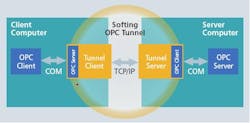Effectively Employ OPC Communications
Originally, OPC was defined as a standardized solution for the recurring task of connecting PC-based applications (for example HMI or SCADA systems) with automation and process control devices. Today, the OPC standard has evolved into a robust data carrier able to transport entire enterprise resource planning documents and even video signals.Standard OPC DA (Data Access) is based on Microsoft’s Distributed Component Object Model (DCOM) technology and is consequently restricted to the Windows operating system. In addition, DCOM communication is blocked by firewalls that prevent clients from accessing data over a wide-area network and the World Wide Web. However, there are a growing number of applications that need to go beyond the standard OPC DA architecture. For example, certain applications require OPC communications between OPC Clients and/or OPC Servers. Other scenarios include OPC communications between different operating systems or through firewalls. The remainder of this document will discuss techniques to effectively complement the OPC standard with Softing’s OPC middleware products.OPC communications without DCOMBixby International Corporation, a custom thermoplastic sheet extruder and laminator based in Newburyport, Mass., was faced with the task to setup an OPC application consisting of a SCADA system running Windows XP SP2 and a gauging application running on Windows 2000. This seemingly easy task turned quickly into a nerve-wracking struggle with the security settings of the underlying DCOM system.Have you ever had the pleasure of configuring the security settings for DCOM to make your OPC application run in a network? It is not easy to say the least, and it has become increasingly more difficult with Microsoft's continued release of new security enhancements for its Windows operating system. Here is the good news: There are alternatives that are worthy of consideration when setting up OPC connections between computers.The OPC Tunnel, part of Softing's OPC Easy Connect Suite, is an effective solution that bypasses DCOM completely. The OPC Tunnel enables high-performance and robust communications between OPC components on networked computers. OPC Tunnel components are installed on both the OPC client computer and the OPC server computer.Communications between the client-side and server-side OPC Tunnel components is realized over a TCP/IP connection (encrypted, if desired). The data between client and server applications is thus tunneled via TCP/IP, bypassing DCOM completely and eliminating time-consuming DCOM setup work. Bixby’s engineers downloaded Softing’s OPC Tunnel and were immediately able to get the OPC application up and running. Said Bixby personnel, "We tried OPC Tunnel products from multiple vendors, but Softing's OPC Tunnel was by far the easiest and fastest to set up. It runs reliably and provides excellent performance at a very affordable price." Client to Client, Server to ServerSofting’s Easy Connect Suite also includes OPC middleware products that support OPC Client to Client and OPC Server to Server communication.An OPC Client to Client link can be used to synchronize PC-based control applications with visualization packages without burdening the underlying OPC Server(s) with additional data requests.OPC Server to Server communications can be used to elegantly merge heterogeneous automation systems. For example, an OPC Server supporting Ethernet/IP can access Rockwell Automation devices while Softing’s S7 OPC Server can access Siemens-based automation equipment. Linking these two OPC Servers effectively bridges between automation systems predominantly used in the U.S. and automation systems predominantly used in Europe.The key in supporting these classes of non-standard OPC communication relationships is to use an “OPC-Gateway.” The OPC-Gateway represents a man-in-the-middle architecture translating between two (or more) Clients or Servers. In case of a Client to Client architecture, the OPC-Gateway acts as an OPC Server that serves both Clients. The main task of the OPC-Gateway is to cross-map the data that flows between the OPC Clients. In case of a Server to Server relationship, the OPC-Gateway takes on the role of an OPC Client. The OPC-Gateway simply cross-maps input data from the one Server to the output data of the other Server and visa versa.Softing's OPC Easy Connect Suite is designed to enhance OPC-based applications. This intelligent set of OPC middleware products simplifies the commissioning and operation of OPC clients and servers, significantly improves the data throughput of your OPC interfaces, and ensures reliable OPC communication links.Softing, a member of the European Steering Committee of the OPC Foundation and author of the OPC Book, actively contributes to the success of OPC by providing high quality OPC products, enabling their customers to stay in the forefront of the industrial communications technologies they deploy.For more information on how Softing can assist you, please visit www.softing.us.

